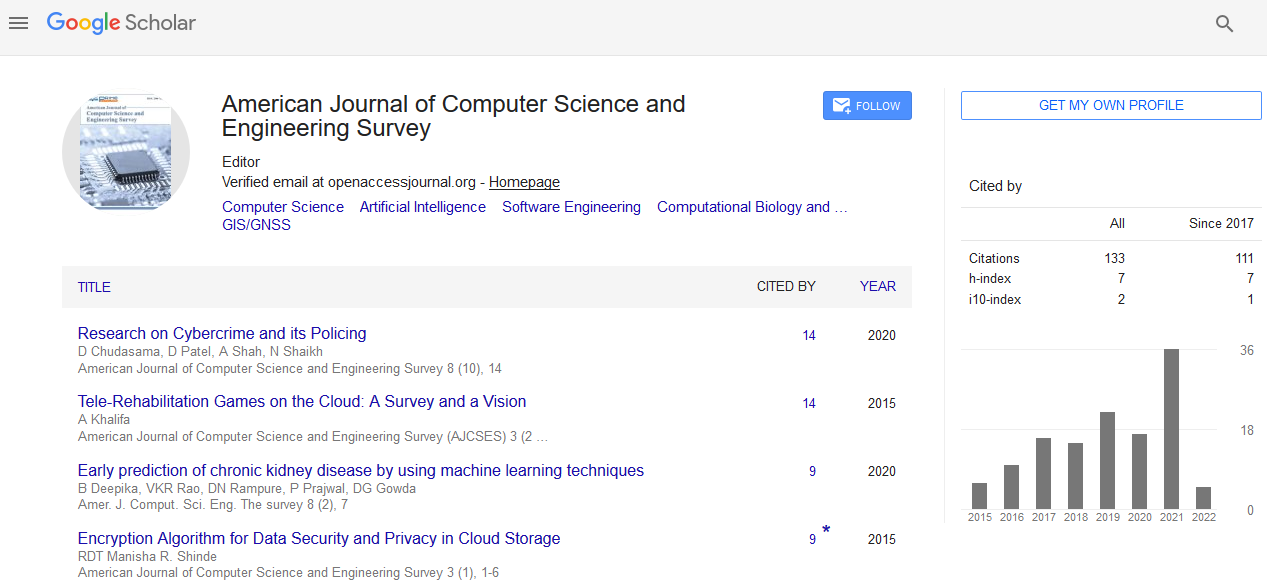Commentary - (2024) Volume 12, Issue 1
Robotics: Exploring Applications across Industries and Domains
Dorian Gian*
Department of Robotics, University of Bern, Switzerland
*Correspondence:
Dorian Gian,
Department of Robotics, University of Bern,
Switzerland,
Email:
Received: 28-Feb-2024, Manuscript No. IPACSES-24-19978;
Editor assigned: 01-Mar-2024, Pre QC No. IPACSES-24-19978 (PQ);
Reviewed: 15-Mar-2024, QC No. IPACSES-24-19978;
Revised: 20-Mar-2024, Manuscript No. IPACSES-24-19978 (R);
Published:
27-Mar-2024, DOI: 10.36846/2349-7238.24.12.02
Description
Robotics, a multidisciplinary field combining computer science,
engineering, and mathematics, has witnessed exponential
growth in recent years, revolutionizing various sectors with
its diverse applications. This paper provides an overview of
robotics technology, its underlying principles, and explores
its applications across industries and domains, ranging from
manufacturing and healthcare to agriculture and space
exploration. By examining real-world examples and emerging
trends, this paper highlights the transformative potential
of robotics in enhancing efficiency, productivity, and safety
across diverse fields. Robotics encompasses the design,
construction, operation, and application of robots autonomous
or semi-autonomous machines capable of performing tasks
traditionally undertaken by humans. These machines can range
from simple industrial manipulators to advanced humanoid
robots equipped with Artificial Intelligence (AI) and sensing
capabilities. Robotics has revolutionized manufacturing
processes, enabling greater precision, efficiency, and flexibility
in production lines. Automated robots perform tasks such as
assembly, welding, painting, and material handling, leading
to increased productivity and cost savings for industries In
healthcare, robots assist surgeons in performing minimally
invasive surgeries with greater accuracy and dexterity.
They also facilitate rehabilitation therapy, patient care, and
telemedicine, improving treatment outcomes and enhancing
the quality of life for patients. Agricultural robots, or agribots,
are transforming farming practices by automating tasks such
as planting, harvesting, and crop monitoring. These robots
enhance precision agriculture techniques, optimize resource
utilization, and contribute to sustainable farming practices.
Robotics plays a crucial role in streamlining logistics operations,
including inventory management, order fulfillment, and package
sorting in warehouses and distribution centers. Autonomous
mobile robots navigate complex environments, increasing
efficiency and reducing labor costs. Robotic spacecraft and
planetary rovers are deployed for exploration missions to
distant planets, moons, and asteroids. These robots conduct
scientific research, collect samples, and provide valuable
insights into planetary geology, climate, and potential habitats
for extraterrestrial life. Collaborative robots work alongside
human operators in shared workspaces, facilitating humanrobot
collaboration and enhancing productivity and safety
in various industries. Integration of AI and machine learning
algorithms enables robots to perceive their environment,
adapt to changing conditions, and learn from experience,
unlocking new capabilities and applications. Swarm robotics
involves coordinating large groups of simple robots to perform
complex tasks collectively. This approach finds applications in
search and rescue missions, environmental monitoring, and
infrastructure inspection. Soft robots, inspired by biological
organisms, are made of flexible materials and exhibit
adaptability and resilience. These robots are suited for delicate
tasks such as surgical interventions, human-robot interaction,
and exploration of confined spaces. Despite the vast potential
of robotics, several challenges must be addressed, including:
Safety concerns regarding human-robot interaction. Ethical
implications of automation on employment and workforce
dynamics. Regulatory frameworks for ensuring the responsible
deployment of robotics technologies. Technological barriers
related to power efficiency, sensor integration, and robustness
in real-world environments. Robotics technology continues to
evolve rapidly, driving innovation and transformation across
industries and domains. From manufacturing and healthcare
to agriculture and space exploration, robots are revolutionizing
how tasks are performed, enhancing efficiency, productivity,
and safety. By addressing challenges, embracing emerging
trends, and fostering interdisciplinary collaboration, the
potential of robotics to solve complex problems and improve
the human condition remains boundless.
Acknowledgement
None.
Conflict Of Interest
None.
Citation: Gian D (2024) Robotics: Exploring Applications across Industries and Domains. Am J Comp Science. 12:02.
Copyright: © 2024 Gian D. This is an open-access article distributed under the terms of the Creative Commons Attribution License, which permits unrestricted use, distribution and reproduction in any medium, provided the original author and source are credited.

